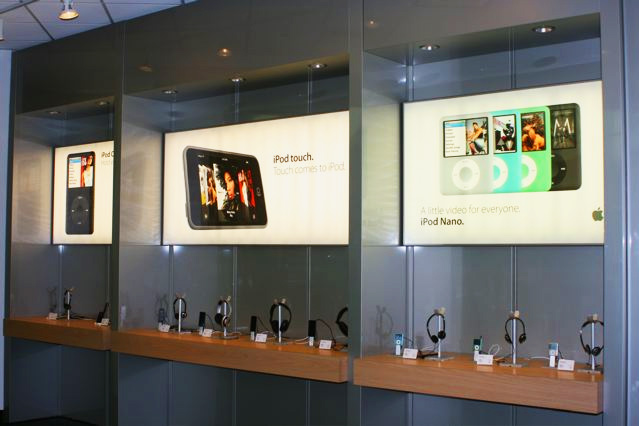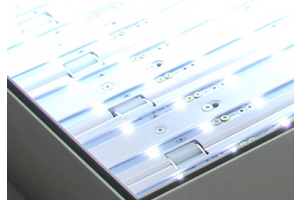5 Ways to Improve Diffusion in an LED Lightbox
As backlit LED lightboxes increase in popularity for commercial and fine art applications as compared to legacy fluorescent models, so does the need to find ways to smooth out the LED light intensity and deliver more uniformity of brightness, to meet the expectations of the viewer. In our previous article 7 Tips on How to Improve Diffusion in Lightboxes, we talked about how to improve lightbox diffusion generally, regardless of lamp type. Here, we’ll specifically focus on LED lightboxes and the unique ways to optimize their light diffusion properties.
-
LAMP BRIGHTNESS — Conspicuously missing from our original article is the idea that variations in lamp brightness may contribute to or detract from uniformity of diffusion. In fact, our own research here at Blue River Digital has concluded that adjusting the brightness of fluorescent lamps has little to no detectable influence on how well a lightbox diffuses. However, this cannot be said of LED lamps, and the reason is simple: LED lamps generate a highly focal pattern of light output, as compared to fluorescent tubes, whose light output is highly diffused at the very outset. This difference in light output pattern between fluorescent and LED lamps is responsible for the differing results obtained when you increase or decrease the intensity (aka brightness) of the two lamp types.
To illustrate this, consider a spotlight on a foggy night, compared to a line of store windows that are lit up. If you dim or brighten the spotlight, its “diffusion” also changes, even if not in a linear relationship to brightness, it still changes from modestly diffused at its “dim” setting, to barely diffused (more “focal”) when bright. Conversely, a set of store windows that is indirectly lit up from within, or possibly a large rectangular electric sign with a lightly-colored graphic face, when adjusted to a dimmer or brighter setting, does not result in the same degree of change in diffusion level. Whether dim or bright, a large, somewhat pre-diffused light source changes very little in its “diffusive” property — unlike the spotlight — or in our case, the LED module.
So our conclusion here is that when LED lamps are dimmed, they diffuse better than when at full brightness. Or more accurately, the more the light from an LED lamp is intensified, the more focal or pinpointed its light output pattern becomes, making it more difficult to mitigate that focality, aka “diffuse” the light output.
Blue River Digital carries tens of lightbox models specifically fitted with LED lamps, plus several other models that are upgradeable to LED. Of all our LED models, at least half of them are also upgradeable to dimmer-controlled circuits, which in turn can deliver an improved diffusion for critical lightbox projects.
LAMP ORIENTATION — Because of the intense focality of LED lamps by their nature, lightbox designs that contain edge-mounted lamps which cast their light “sideways” through an etched diffuser plate are especially popular with LED-powered systems. This is because the side-throw design boosts diffusion simply by delivering an indirect transmission of light, first laterally through the etched plate, and then forward to the display face — instead of direct, unhindered, straight-line from lamps to display face
For this reason, if you want the best of diffusion in an LED lightbox, it’s hard to go wrong with an “edgelit” design. Edgelit LED lightboxes are the most popular lightbox configuration these days for several reasons, and uniform diffusion is near the top of the list.
LAMP BUBBLES — Not many LED lightbox manufacturers offer lamp “bubbles”, but several of Blue River Digital’s premium models include these miniature, translucent lenses by default. A lamp bubble, as seen here, is simply a mini-diffuser mounted on a single LED module. The bubble serves to scatter light as soon as it emits from the module, thus making it easier for the diffused face lenses and/or diffused graphic film to finish the job of smoothing out the light intensity, with the ideal goal being an unquestionably uniform glow at the display face.
SPACE BETWEEN LAMPS — Back in the ‘ancient’ days of mostly fluorescent lightboxes, since fluorescent tubes stretched the length of a lightbox in one direction, the only axis left to worry about was the 90° opposing one,in terms of how many tubes, or what “lamp density” was found. Now with LED lightboxes, we have to think about both “X” and “Y” axes, because each LED lamp is so tiny that of course we need a two-dimensional “matrix” of them to adequately illuminate the display face of your lightbox.
Most direct-backlit LED lightboxes are fitted with linear strips of LED lamps all in a single-row per strip. LED lamp strips are available in all ranges of lamp density, from several lamps per inch, up to one lamp every couple of inches or more. The spacing between lamps on an average lamp strip in a direct-backlit LED lightbox is between 1.5 and 2.5 inches. Of course the closer the lamps, the less “light drop-off” can occur between lamps at the display face, thus reducing hot spots or variations in brightness.
Next we have the spacing between strips of LED’s, and here’s where you get all manner of variety from one lightbox model to the next, depending on depth of lightbox cabinet, intended overall brightness, and of course budget.
If you’re shopping for LED lightboxes and you have a particular requirement with regard to overall brightness, uniform diffusion and/or budget, find out what variations of models — and also flexibility within a particular model — are available from your suppliers.
DISPERSION ANGLE — Our last tip on how to improve light diffusion for your LED lightboxes, and perhaps the least intuitive, is the dispersion angle of the LED modules. Dispersion angle is the degree of spread of light as it leaves the lamp and fans outward, similar to a floodlight vs. a spotlight. Some LED modules have wider dispersion angles than others(these are commonly called “wide angle LED’s”), and this property functions hand-in-hand with lamp density to either improve or degrade diffusion uniformity. As a matter of fact, a good test of the detail and quality of your lightbox source is to inquire about dispersion angle. If your supplier is not able to provide specification on dispersion angle, chances are you’re dealing with narrower angles, plus parts and materials that generally require lower investment on the part of your supplier.
Usually you don’t see a consumer-level option for dispersion angle, but if you have a super-critical diffusion application, and you’re having your lightboxes built-to-order, dispersion angle is an important part of the formula, in addition to lamp spacing and distance of lamps from display face.








